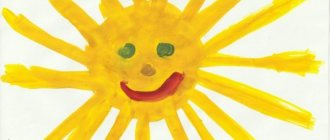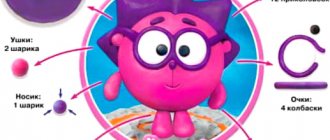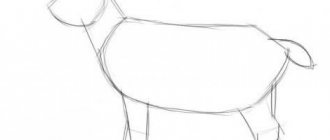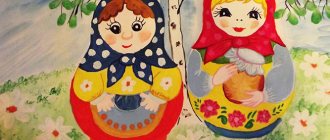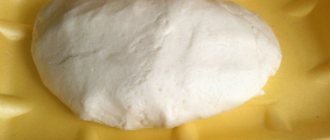On the topic: methodological developments, presentations and notes
Plan of drawing notes (preparatory group) on the topic: “Winter Landscape” using the non-traditional “Imprint” technique (drawing with vegetables).
Program content: Learn to draw rowan, highlighting the characteristic features of the bunch. Reinforce the idea of the color red; cultivate interest in collective creativity. Continue learning doat.
MBDOU "CRR - kindergarten "Bell" Summary of direct educational activities in drawing in the 1st junior group "Winnie the Pooh" Topic: "Wheels for the train" (non-trad.
summary of a drawing lesson in the junior group “Beasts in the Forest.”
Drawing outline for Cosmonaut Day using non-traditional drawing techniques.
Source
Summary of a drawing lesson, middle group on the topic "Boots"
Abstract of OOD on artistic and aesthetic development
topic: " Boots "
.
Middle group
.
Target:
teach children to conceive and implement the planned pattern in their work.
Tasks:
- develop the ability to dress up
decorate the object base using geometric pattern elements in a decorative image;
- learn to confidently draw a straight, wavy line, dots;
- develop the ability to apply a symmetrical pattern on several subject bases;
- maintain the correct posture when drawing;
- work carefully with gouache;
- hold the brush correctly;
- work with the end of the brush;
- continue to develop children’s knowledge about shoes and their parts;
- train in naming the parts of shoes: boot, toe, heel, heel, sole.
Equipment:
presentation with an image of shoes, a pair of boots, boots with decorated tops, a supporting picture with types of patterns
(circle, dot, wavy line, straight line)
. Oilcloths, gouache paints, brushes, jars of water, napkins, tinted sheets of different colors with outlines of boots for each child.
Progress of the lesson:
Children sit in a semicircle in the center of the group, with pictures of shoes on the board.
The teacher offers to guess the riddle:
Snow. My feet are frozen.
We need to put on... ( boots )
After the children guess the riddle, the teacher displays a picture of a pair of boots on the screen, asks them to examine and determine what parts the boots consist of: top, toe, heel, sole, heel.
— Today our group operates a shoe workshop. Let's help the shoemaker make his boots beautiful. And now I suggest you take your seats in the shoe workshop, take your places at the tables.
Next, the teacher displays several options for boots, decorated in various ways.
— Before you get started, I suggest you look at the screen on how you can decorate the boots. Please note that both boots in a pair have the same pattern and are similar to each other.
After considering options for decorating boots, the teacher displays a reference picture with variant patterns (dot, wave, stripe, square). Invites children to think about what patterns can be made.
- Look how I decorate my boots. First of all, I will take the brush in my hand, pay attention to how I hold it. First, I dip it in water and squeeze it a little on the edge of the jar and dip the tip of the brush into the paint of the color I need. I don’t use a lot of paint to make the pattern neat. I draw a wavy line in the middle of the boot, raising the brush up and smoothly lowering it down; if the paint on the brush runs out, I lightly moisten it in water and dip it into the paint. I continue to carry out the wave. The wavy line is ready. We noticed that the pattern on both boots is the same, so on the second boot I draw the same wavy line. I rinse the brush thoroughly, squeeze it on the edge of the jar and dip it into paint of a different color. Now I draw dots in the recesses on top of the wave, and I draw the same on the second boot. I put the brush in water again, rinse it, wring it out and dip it into paint of a different color. I paint dots in the recesses under the wave on both boots; if the paint on the brush runs out, I wet it a little in water, pick up paint and continue decorating the boot further. Please note that the pattern is the same on both boots. I decorated my boots, while we remembered the rules of working with gouache.
- Now I suggest you paint your boots.
— We helped the shoemaker and decorated the boots. Now I suggest you warm up a little. Stand in a circle (carrying out physical education).
Physical education minute
We dressed our feet in new boots, (We put our socks on one by one)
You walk, legs, straight along the path. (Walking in place)
You walk, stomp, don’t splash in puddles, (Stamp in place)
Don't go into the mud, don't tear your boots. (Jumping in place)
“We rested a little, stretched our legs, and now we’re going back to our workshop to see what kind of boots we came up with.” I suggest taking your drawings and laying them out on the table (together with the children, discuss what patterns they used, mark the most successful works, note in which works something can be added or changed, note that the pattern on both boots is the same and is located on boot, identify the appropriateness of its location; praise the children for the work done).
Summary of educational activities on subject drawing for children 5–6 years old with mental retardation “Rubber boots”
Tatiana Kulagina
Summary of educational activities on subject drawing for children 5–6 years old with mental retardation “Rubber boots”
-Systematize children’s knowledge about seasonal clothing and shoes.
— To develop children’s in visual arts,
— Develop aesthetic perception of household items ,
— Cultivate goodwill when assessing the work of comrades, develop emotional responsiveness;
-Develop a caring attitude towards shoes.
-activation of the dictionary on the lexical topic “Clothing. Hats. Footwear: Autumn, it’s raining, rubber boots , leather boots , shoes, house slippers;
-enrichment of vocabulary: introduce children to the concept of “pair of shoes”
2. Preliminary work:
Examination of illustrations: Autumn, Clothes, Shoes, Hats;
Observing the weather in the kindergarten area, observing changes in the clothing of children and adults .
Didactic games: “Collect a picture”
,
“Dress the doll for a walk”
;
“Make clothes from parts”
; Different types of lacing.
Printed board game “Loto. Cloth. Shoes. Hats"
;
V. Stepanov “The ABC of the Seasons”
Poems and stories about autumn
S. Mikhalkov “Masha the Confused”
E. Blaginina “How smartly you are dressed.” Watching cartoons and educational films about shoes.
3.Materials and equipment:
- sippy cups with water,
- brushes of two sizes,
4. Scenario of an educational situation.
1. Introduction to the game situation (elements of psycho-gymnastics)
:
-Children, what time of year is it now?
Walk in boots . We will go for a walk in rainy weather in rubber boots We take off our boots , put them in a box and go to the tables.
Organization and conduct of classes
Classes within the framework of the broad topic “Clothing and footwear” are planned in conjunction with versatile pedagogical work aimed at the cognitive, speech, social-communicative, artistic and aesthetic development of children. Separate drawing classes can be conducted independently or as a creative part of short-term and long-term projects on this topic (“Folk costume”, “Types of clothing and shoes”, “Dymkovo painting”, etc.).
The senior group has one drawing lesson per week. The total duration of continuous activity should not exceed 20–25 minutes; methodologists and psychologists recommend performing physical exercises (finger, breathing, motor exercises) for 5 minutes to relieve psychological and mental stress, as well as prevent physical fatigue in children.
Lesson outline
- Organizational part (3–5 minutes). The practical part of the lesson can be preceded not only by reading fairy tales, poems or riddles, but also by watching educational pictures, presentations, a fragment of an educational film or cartoon. The information and familiarization stage involves awakening children's interest in the task and becoming familiar with the depicted items of clothing or shoes. It is necessary to include surprise moments, elements of theatrical or didactic games that stimulate creative activity and create a psychologically comfortable environment.
- Practical part - the teacher explains the essence of the task (3-5 minutes). Older preschoolers are given more freedom in the drawing process; showing a sample prepared by the teacher is used less and less for sketching, more often to demonstrate new techniques or clarify the sequence of work. Techniques that have already been mastered do not require additional demonstration.
- Independent work of children (15–20 minutes). The teacher prompts and helps if children have difficulties or misunderstandings while drawing.
- The final part is the analysis and assessment by children of their works and the drawings of their comrades. Children are taught to formulate their point of view with reason and verbally express the aesthetic perception of creative works (3-5 minutes).
Presentation on the topic “Clothing and footwear”
Algorithm of questions for conversation Game for developing vocabulary on a lexical topic Game for developing vocabulary on a lexical topic Game for selecting adjectives Game for developing observation skills Game for developing vocabulary on a lexical topic Game for developing long-term memory, mental operations of synthesis and analysis Game for developing visual attention Game to consolidate ideas about color Game to consolidate ideas about color Game to develop thinking Game to develop concentration Game to develop concentration Game to develop mental operations of synthesis and analysis Game to develop mental operations of synthesis and analysis Game to develop concentration Riddles for the development of logical thinking and replenishing vocabulary on the topic Exercise to activate the vocabulary Tasks to activate memory and logical thinking Exercise to activate logical thinking
Lesson notes for the senior group
In the notes, the teacher formulates the objectives of the lesson:
- to develop knowledge about the types and purposes of clothing, hats and shoes, to introduce the seasonal classification of clothing;
- develop a sense of color, learn to find an interesting and harmonious combination of colors;
- consolidate the ability to draw according to a model, teach drawing patterns based on a free design;
- improve technical skills in using a pencil and brush: draw dots, curls, wavy, straight, rounded lines with the tip and entire surface of the brush;
- freely maneuver the brush in different directions;
- be able to adjust the paint set and mix different colors to obtain the desired shade.
Lesson summary on the topic “Hat for a doll” (author Yu. Balandina)
| Goal: To form children’s understanding of decorative art as the decoration of objects. Objectives: 1. Consolidate children’s knowledge about hats. 2. Development of children’s ideas about the arrangement of elements on the cap (vertically, horizontally, obliquely) and decoration with strokes, stripes, dots, circles. 3. Development of fine motor skills of the hands and hand-eye coordination. 4. Fostering a positive emotional attitude towards visual activity and the results of one’s work. Methods and techniques: questions, visual material, musical accompaniment, artistic expression, display, explanation, advice, clarification, help, encouragement, analysis of children's work, play. Preliminary work: reading N. Nosov’s “Living Hat”, looking at the album “Filimonov Whistles”, conversation on the topic of Filimonov painting, learning finger gymnastics and physical education lessons. Benefits and equipment. Silhouettes of hats, brushes No. 2, gouache paints, a glass of water, coasters, napkins, paper dolls, diagrams of pattern elements. Individually differentiated approach: children with an average level of artistic and aesthetic development come up with an independent version of the pattern, and with a low level, according to the scheme and with the help of an adult. 1. Organizational stage. — Guys, a friend’s doll was invited to go for a walk. But she can't. Why do you think? (It’s cold, and she’s not wearing a hat) - Yes, it’s late autumn, the weather is cold and children put on warm hats when they go for a walk. How can we help the doll? (Draw) - What other hats do you know? (Cap, Panama, scarf) - Well done! Finger gymnastics. 2. Practical stage. — Hats can be decorated with a pattern. Let's sit down at the tables and think about what pattern we can depict on the hat. — What elements of folk ornament do you know? (Stripes, Christmas trees, flowers) - Where can we depict stripes and Christmas trees? (At the bottom of the cap on the lapel) - Where can you depict a flower? (In the middle of the hat on the pompom) - Let's look and remember the varieties of the Filimonov pattern. — What colors alternate? (Red, green) - First, draw a line from left to right at the bottom of the header and slightly retreating from the bottom edge. Then a line is drawn from top to bottom, inclined lines or herringbones. - Look and remember the varieties of Filimonov flowers. Patterns of circles with the addition of sticks and dots. — Each of you will get a different ornament. Do not forget about the rhythmic alternation of pattern elements. — What elements will you draw, Egor. (Christmas tree, flower) - What kind of person are you, Tanya? (Stripes, flower) - Well done - Now let's play. Physical education minute. 3. Independent work of children. - Now you will turn into little artists. Turn left to right and turn into an artist! - Let's go draw hats for the dolls. How do we sit at tables? (Directly) - How do we hold the brush? (Three fingers) - I suggest decorating the hats. Decorate as you wish. Children draw to the sound of music. 4. Summing up. The drawings are posted on the board. - What wonderful hats they turned out to be. Well done boys! What kind of hat would you try on your doll, Gleb? (response from several children) Doll: I’ll pull my hat over my forehead, I’ll dress warmly, I’ll invite my friends for a walk, We’ll have more fun. Thank you guys for your hats, I’ll go for a walk in them. |
